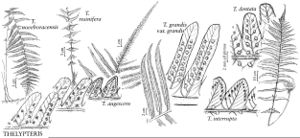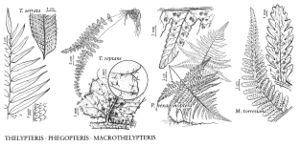Thelypteridaceae
Plants terrestrial or on rock [epiphytic]. Stems creeping to erect, scaly at apex. Leaves monomorphic or somewhat dimorphic [dimorphic]. Petiole in cross section with 2 crescent-shaped vascular bundles at base. Blade pinnate to pinnate-pinnatifid, rarely more than 2-pinnate [simple]; rachis grooved adaxially or not, grooves not continuous with grooves of next order. Veins free or anastomosing, running to margin, areoles with or without included free veinlets. Indument of transparent, needlelike, hooked, septate, or stellate hairs, or rarely hairs lacking. Sori inframedial to supramedial, occasionally nearly marginal, round or oblong, rarely elongate along veins; indusia reniform or sometimes absent. Spores bilateral, monolete [rarely globose-tetrahedral and trilete], usually with a prominent, crested, echinate, or reticulate perispore. Gametophytes green, cordate, usually hairy or glandular; antheridia 3-celled.
Distribution
Mostly tropical.
Discussion
Members of Thelypteridaceae have historically been associated with Dryopteridaceae (in particular, Dryopteris) but in fact have no close relationship with that family. Thelypteris and allies differ from Dryopteris and allies by their indument of transparent needlelike hairs (versus needlelike hairs absent in Dryopteridaceae); general absence of blade scales (versus blade scales often present); petiole vasculature in cross section with two crescent-shaped bundles (versus many round bundles arranged in an arc, Athyrium and allies exceptional); generally 1-pinnate to pinnate-pinnatifid blades (versus often more divided); veins usually not forking in the ultimate segments (versus often forking); adaxial grooves discontinuous from rachis to costae, or grooves lacking (versus grooves often continuous); and chromosome base numbers from 27–36 (versus generally 40, 41).
Genera 1 to ca. 30, depending on circumscription, species ca. 900 (as circumscribed here, 3 genera and 25 species in the flora).
Selected References
None.
Lower Taxa
Illustrations
Key
| 1 | Blades 1-pinnate to deeply pinnate-pinnatifid; costae grooved adaxially; veins meeting margin at or above sinus or united below sinus. | Thelypteris |
| 1 | Blades 2-pinnatifid, with pinnae at least in distal 1/2 of blade connected by wings along rachis, or blades 2-pinnate-pinnatifid; costae not grooved adaxially; veins commonly meeting margin above sinus. | > 2 |
| 2 | Pinnae free, rachis not winged; blades 2-pinnate or more divided; costal hairs septate, often longer than 1 mm; indusia small, less than 0.3 mm diam. | Macrothelypteris |
| 2 | Pinnae mostly connected by wings along rachis, the wings often forming semicircular lobes between pinnae; blades 2-pinnatifid; costal hairs not septate, shorter than 0.5 mm; indusia absent. | Phegopteris |

